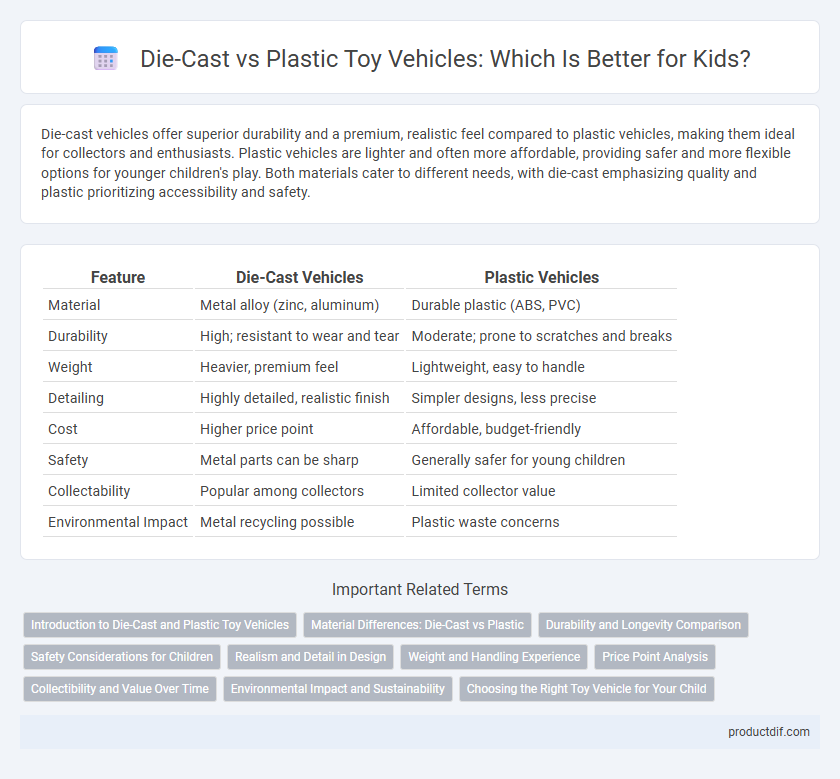Die-cast vehicles offer superior durability and a premium, realistic feel compared to plastic vehicles, making them ideal for collectors and enthusiasts. Plastic vehicles are lighter and often more affordable, providing safer and more flexible options for younger children's play. Both materials cater to different needs, with die-cast emphasizing quality and plastic prioritizing accessibility and safety.
Table of Comparison
| Feature | Die-Cast Vehicles | Plastic Vehicles |
|---|---|---|
| Material | Metal alloy (zinc, aluminum) | Durable plastic (ABS, PVC) |
| Durability | High; resistant to wear and tear | Moderate; prone to scratches and breaks |
| Weight | Heavier, premium feel | Lightweight, easy to handle |
| Detailing | Highly detailed, realistic finish | Simpler designs, less precise |
| Cost | Higher price point | Affordable, budget-friendly |
| Safety | Metal parts can be sharp | Generally safer for young children |
| Collectability | Popular among collectors | Limited collector value |
| Environmental Impact | Metal recycling possible | Plastic waste concerns |
Introduction to Die-Cast and Plastic Toy Vehicles
Die-cast toy vehicles are crafted from metal alloys, offering enhanced durability, realistic weight, and detailed finishes compared to plastic vehicles. Plastic toy vehicles provide lightweight, affordable options with greater flexibility in design and vibrant color variations. Understanding the material differences aids consumers in choosing between the sturdiness of die-cast models and the versatility of plastic toys.
Material Differences: Die-Cast vs Plastic
Die-cast vehicles are made from a metal alloy, typically zinc with small amounts of copper and aluminum, offering superior durability and heft compared to plastic vehicles, which are crafted from polymers such as ABS or PVC. Metal construction in die-cast toys provides enhanced detail retention and resistance to wear, while plastic models offer lighter weight and greater flexibility in molding intricate shapes and vibrant colors. The choice between die-cast and plastic materials impacts the toy's tactile feel, longevity, and collector value.
Durability and Longevity Comparison
Die-cast vehicles offer superior durability and longevity compared to plastic vehicles due to their metal construction, which resists wear and tear over time. The sturdy zinc alloy material used in die-cast models withstands impacts and maintains structural integrity, while plastic vehicles are more prone to cracks and fading from UV exposure. Collectors and enthusiasts prefer die-cast vehicles for their lasting value, making them ideal for prolonged display and play.
Safety Considerations for Children
Die-cast vehicles offer enhanced durability and reduced risk of breakage compared to plastic vehicles, minimizing choking hazards for children aged three and older. Plastic vehicles, while lightweight and flexible, may contain small detachable parts or sharp edges that pose safety risks for younger children. Ensuring adherence to safety standards such as ASTM F963 and CPSIA guarantees both die-cast and plastic toys meet rigorous testing for non-toxic materials and secure construction.
Realism and Detail in Design
Die-cast vehicles offer superior realism and intricate detail in design compared to plastic vehicles, as their metal construction enables finer textures, sharper contours, and authentic weight distribution. Precision casting techniques used in die-cast models replicate real vehicle features such as badges, grills, and paint finishes with greater accuracy. Plastic vehicles often lack this level of detail and durability, resulting in less convincing replicas and a more toy-like appearance.
Weight and Handling Experience
Die-cast vehicles typically have a heavier weight compared to plastic vehicles, enhancing the tactile and realistic handling experience for collectors and children. The added weight in die-cast models results in a sturdier feel and smoother movement on surfaces, while plastic vehicles are lighter, promoting easier maneuverability and faster play. Weight directly impacts the overall handling dynamics, with die-cast models providing a more authentic and satisfying grip.
Price Point Analysis
Die-cast vehicles typically command higher price points due to their metal construction, durability, and detailed craftsmanship, often appealing to collectors and enthusiasts. Plastic vehicles offer a more affordable alternative, benefiting from lower production costs and mass-market accessibility, making them popular for everyday play. Market analysis shows die-cast models average 20-50% higher retail prices compared to plastic counterparts, reflecting material and manufacturing value differences.
Collectibility and Value Over Time
Die-cast vehicles typically hold higher collectibility and value over time due to their durability, detailed craftsmanship, and limited production runs appealing to serious collectors. Plastic vehicles, while more affordable and diverse in design, often depreciate faster and lack the long-term investment potential found in die-cast models. Collectors prioritize rarity, material quality, and brand reputation, making die-cast vehicles a preferred choice for preserving value.
Environmental Impact and Sustainability
Die-cast vehicles, typically made from metal alloys like zinc and aluminum, offer greater durability and recyclability compared to plastic vehicles, which often contribute to long-term environmental pollution due to their non-biodegradable nature. The production of die-cast toys generally involves higher energy consumption but results in products with a longer lifespan, reducing the frequency of replacements and overall waste. Plastic vehicles, especially those made from non-recycled plastics, pose significant challenges in waste management and contribute heavily to microplastic pollution, undermining sustainability efforts.
Choosing the Right Toy Vehicle for Your Child
Die-cast vehicles offer durability and realistic details, making them ideal for collectors and older children who appreciate authenticity. Plastic vehicles provide lightweight playability and versatility, suitable for younger kids who need safe, easy-to-handle toys. Selecting the right toy vehicle depends on your child's age, interests, and the balance between durability and imaginative play.
Die-cast vehicles vs plastic vehicles Infographic

 productdif.com
productdif.com